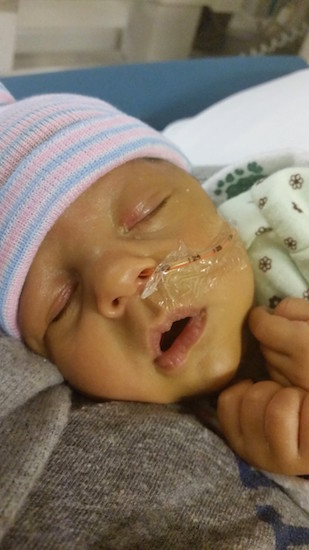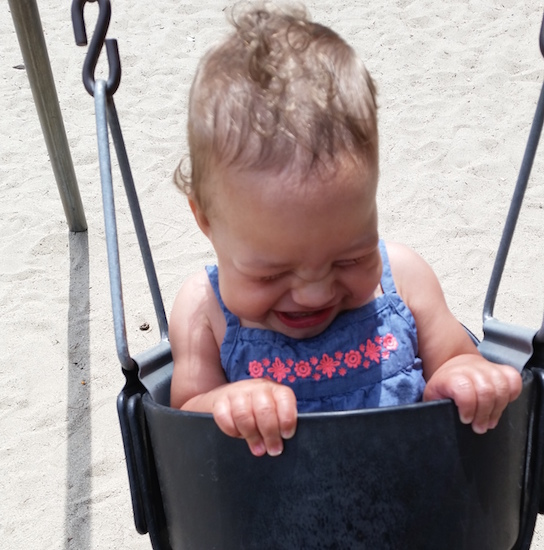It was the perfect day for a picnic; the sun was shining, but it wasn’t too hot. My 1-year old, Emerson, and I were on a blanket next to the playground having a leisurely lunch. As I handed her a cut-up blueberry, I watched her adoringly as she squished it between her tiny cocktail sausage fingers, brought it to her sweet little mouth, rolled it around with her tongue and then… spit it out. This was strange because she’s always liked blueberries. So I handed her another and again, she rolled it around and spit it out. We moved on to the other foods and one after another, in they went and moments later, out they came.
My mind raced with worry. Within 10 minutes I was on the phone with her pediatrician and her occupational therapist talking about scary potential causes like sensory processing issues, her being at risk of aspiration, etc., and totally normal baby causes like teething and self-will.
Now, a quick Google search would likely put most parents at ease, as the list of results was long and full of parents going on about their 1-year-olds going through “spitting-out-food” phases. Behaviors that left as quickly as they came. But, and believe me when I say I don’t want to sound like a woman who thinks she’s extremely unique, I’m not most parents. I’m the parent of a child whose diagnosis is grey, potentially quite scary and at the same time, potentially full of hope.
Emerson’s diagnosis is HIE: hypoxic ischemic encephalopathy or brain damage caused by loss of oxygen at birth. Long-term results can include epilepsy, cerebral palsy, developmental delay, motor impairment, neurodevelopmental delay and cognitive impairment.
The range of symptoms and conditions is long and the severity spectrum is wide, and since the severity of a child’s impairment can’t be determined until 3 to 4 years old, we just don’t know where Emerson will land. So every “phase” or behavior that may be of little worry to some can be a telling sign for Emerson and her development, and as I watched her spitting out her food, my stomach twisted itself into knots.
I’d like to think of myself as a realist with optimistic tendencies. So when I look at Emerson and all the amazing milestones she’s reached despite doctor’s terrible prognoses, I attribute her progress to a combination of real world effort and spiritual mumbo-jumbo: lots of love, hard work, her intrinsic fiery spirit, the partnership of my husband, myself and her care team, prayers and what I believe is a big splash of God-given grace.
We were told she would likely never eat orally, and she came home with a feeding tube. Now, she drinks from a bottle and a sippy cup and eats table foods and baby foods every day. We were told she would likely never motor or move without assistance. Now she crawls around, pulls herself up on furniture and cruises with increasing confidence. We were told she may never be able to express emotions. Now she smiles, laughs, cries, plays peek-a-boo and squeals with delight over the itsy bitsy spider and this little piggy. We were told it would be too hard, that we had an out and could (and should) walk away. Now she’s a bright, beautiful and indispensable part of our family who brings joy everywhere she goes.
She’s truly a miracle – a miracle story still being written with many unknowns ahead. Will she be able to dress herself? Will she be able to go pee-pee on the potty? Will she be able to grasp the alphabet, counting, sorting shapes, cut with scissors, write her name? Will she be able to have relationships with her peers? A best friend? And then the far-off, distant future stuff, like support herself? Be independent? Will she ever fall in love?
Like most parents of babies both with and without special needs, we love our baby unconditionally and see her as an absolute blessing. Loving her completely, body and soul, is easy. It’s the grey area, the not knowing what’s next, that’s hard. And nobody wants to talk about the grey area. Not the doctors, not the therapists, not our friends, not our family.
I recently took a quiz on Facebook to determine if I’m an optimist, pessimist or realist. A highly reputable source of information, I know. As it turns out, I am the uber-realist, and I can see how that’s true in my need to talk about the grey area, to have it acknowledged and not glossed over. When everyone comments on how well Emerson’s doing, how she seems perfectly normal, how only time will tell, I enthusiastically agree. But I also know the story is still writing itself, and sometimes the present, while precious, is terrifying. And it would be nice to talk about that, too.
If we have a friend with depression, we may be inclined to use phrases like “Cheer up!” or “It’s not that bad, it could be a lot worse,” but that person likely just needs a hug and a lot of understanding. To be accepted exactly where they are. And I think parents with children of special needs need the same – to be accepted exactly where we are.
Even when there are no words of comfort to offer, you can always lend a compassionate ear and ask questions that allow us to talk about and process our fears. It may be uncomfortable and against our nature to always look on the bright side, but looking at the grey area is OK to do – at least once in a while – too.
The Mighty is asking its readers the following: What’s one secret about you or your loved one’s disability and/or disease that no one talks about? If you’d like to participate, please send a blog post to community@themighty.com. Please include a photo for the piece, a photo of yourself and 1-2 sentence bio. Check out our “Share Your Story” page for more about our submission guidelines.


